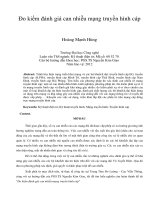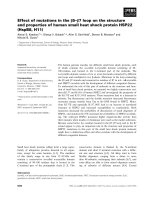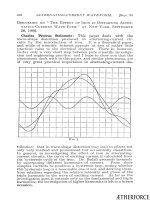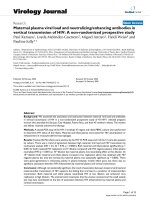Effect of Ich Tri Vuong capsule on plasma lipid level and degree of atherosclerosis in cholesterol fed- rabbits
Bạn đang xem bản rút gọn của tài liệu. Xem và tải ngay bản đầy đủ của tài liệu tại đây (588.85 KB, 9 trang )
JOURNAL OF MEDICAL RESEARCH
EFFECT OF ICH TRI VUONG CAPSULE ON PLASMA
LIPID LEVEL AND DEGREE OF ATHEROSCLEROSIS IN
CHOLESTEROL-FED RABBITS
Le Thi Minh Phuong1, Nguyen Tran Thi Giang Huong1,
Do Thi Phuong1, Nguyen Thi Tuyet Nga2
1
Faculty of Traditional Medicine, Hanoi Medical University,
2
Military Institute of Traditional Medicine
Ich Tri Vuong capsules (ITV) (components Ginkgo biloba, Radix Salviae miltiorrhi zae, Radix Astragali
membranacei and Radix Angelicae sinensis) is used to treat diseases caused by atherosclerosis. This
study was designed to assess the effects of ITV on plasma levels of total cholesterol, triglyceride,
Low-density lipoprotein (LDL), High-density lipoprotein (HDL) and degrees of aorta atherosclerosis in
rabbits with induced atherosclerosis by high cholesterol feeds. 50 New Zealand White rabbits were
divided into 5 groups, 10 per group. Experiment conditions were carried out for 8 weeks. Normal group:
fed with water 2 ml/kg/day. Control group: fed cholesterol 0.5 g/kg/day + water 2 ml/kg. Atorvastatin
group: fed cholesterol 0.5 g/kg/day + Atorvastatin 5 mg/kg/day. ITV dose 1 group (60 mg/kg/day):
fed cholesterol 0.5 g/kg/day+ ITV 60 mg/kg/day. ITV dose 2 group (180 mg/kg/day): fed cholesterol
0.5 g/kg/ngày + ITV 180 mg/kg/day. The results suggest that Ich Tri Vuong 180 mg/kg/day may
decrease plasma levels of Total cholesterol and LDL and reduce atherosclerotic lesions of rabbits
with induced atherosclerosis by high cholesterol feeds when compared to control group. These effects
were equivalent to Atorvastatin 5 mg/kg/day and better than Ich Tri Vuong 60mg/kg/day. There were
no significant differences in HDL and Triglyceride of ITV groups when compared to control group.
Key works: Ich Tri Vuong, Atherosclerosis, plasma lipid
I. INTRODUCTION
Atherosclerosis is a disease of large and
medium arteries. Lesions begin as fatty
streaks, caused by massive accumulation
of LDL oxidative product [1; 2] with high
blood cholesterol LDL is increased in
the plasma as well, and LDL is subject to
oxidative modifications in the subendothelial
space. Monocytes attache to endothelial
Corresponding author: Le Thi Minh Phuong, Faculty
of Traditional Medicine, Hanoi Medical University
Email:
Received: 05 June 2017
Accepted: 16 November 2017
JMR 111 E2 (2) - 2018
cells. Adherent monocytes migrate into
the subendothelial space and differentiate
into macrophages. Uptake of oxLDL by
macrophages via scavenger receptors
leads to foam cell formation. Interactions
between macrophage foam cells establish
a chronic inflammatory process. Smooth
muscle cells migrate to the side of
inflammation. Necrosis of macrophage
and smooth muscle cell-derived foam
cells leads to the formation of a necrotic
core and accumulation of extracellular
cholesterol, creating a plaque. Macrophage
secretion of matrix metalloproteinases and
27
JOURNAL OF MEDICAL RESEARCH
neovascularization contribute to weakening
of the fibrous plaque. The ruptured plaque
is exposed to plasma components,
causing the recruitment of platelets, and
the formation of a thrombus on the medial
portion of the arterial wall. The thrombus
proliferates and secretes extracellular
matrix proteins that form a fibrous plaque
[1]. Atherosclerosis progresses slowly over
years, and can cause stroke, myocardial
infarction, and peripheral artery disease.
These are the mojor causes of disability
and mortality. Therefore, treatment of lipid
metabolism disorders, especilly high special
LDL, plays an important role in preventing
atherosclerosis requires [2]. Recently,
research show that many herbal medicines
that are used for treating diseases caused
by atherosclerosis have an effect on lipid
metabolism and preventing atherosclerosis
[3; 4].
Ich Tri Vuong capsule component
include: Folium Ginkgo biloba, Radix Salviae
miltiorrhi zae, Radix Astragali membranacei,
and Radix Angelicae sinensis. This capscule
is used in the treatment of chronic vertigo,
headache, and insomnia caused by cerebral
atherosclerosis.Ich tri vuong components
were used in the “Angelica decoction
for enriching plasma” (Radix Astragali
membranacei, Radix Angelicae sinensis),
a traditional medicine formula which
effects plasma lipid and the expression
of genes related to foam cell formation in
the early stages of atherosclerosis [5].
Other components of Ich Tri Vuong, Folium
Ginkgo biloba and Radix Salviae miltiorrhi
zae, also effect plasma lipids in in-vitro and
in-vivo [6 - 8]. Research has shown that Ich
28
Tri Vuong capsule has no acute and sub
acute toxicities [9]. To hlear more about Ich
Tri Vuong capsule is mechanism of action,
this study was designed to assess the effect
of Ich Tri Vuong capsule on plasma level of
total cholesterol, triglyceride, LDL, HDL and
the degree of aorta atherosclerosis in an
induced atherosclerosis by high cholesterol
feeds rabit model.
II. SUBJECTS AND METHODS
1. Animal
New Zealand and White rabbits (both
male and female gender, body weight 1.8
– 2.5 kg) were supplied by Son Tay Goat
and Rabbit Research Center. The rabbits
were fed with standard rabbit food in the
laboratory 7 days prior to the experiment.
2. Material
Ich Tri Vuong capsule
Ich Tri Vuong capsule (ITV) components
include 40 mg Folium Ginkgo biloba extract,
150 mg extract of Radix Salviae miltiorrhi
zae, and Radix Astragali membranacei,
Radix Angelicae sinensis. ITV capsules
were supplied by the National Institute of
Drug Quality Control and stored at room
temperature. Dose 1 in rabbit was 60 mg/
kg/day, dose 2 in rabbit was 180 mg/kg/day.
Atorvastatin
Atorvastatin 20 mg tablet, product
of Standa Vietnam, stored at room
temperature. Dose in rabbits was 5mg/kg/
day.
Cholesterol oil
Pure cholesterol (product of MerkGermany) was dissolved in peanut oil
(product of Tuong An company).
JMR 111 E2 (2) - 2018
JOURNAL OF MEDICAL RESEARCH
3. Methods
Rabbits were devided to 5 groups of 10
animals each. Experiment conditions were
carried out for 8 weeks.
Normal group: fed water 2 ml/kg/day.
Control group: fed cholesterol oil 0.5 g/
kg/day, 1ml/kg, 2 hours later fed water 2 ml/
kg/day.
Atorvastatin group: fed cholesterol oil
0.5 g/kg/day, 1ml/kg, 2 hours later fed
Atorvastatin 5mg/kg/day.
ITV dose 1 (60 mg/kg/day): fed
cholesterol oil 0.5 g/kg/day, 1ml/kg, 2
hours later fed Ich Tri Vuong 60 mg/kg/day
(equivalent to clinical dose).
ITV dose 2 (180 mg/kg/day): fed
cholesterol oil 0.5 g/kg/day, 1ml/kg, 2 hours
later fed Ich Tri Vuong 180 mg/kg/day (three
time higher than clinical dose).
Determination of plasma lipid levels
The plasma triglycerides (TG), total
cholesterol (TC), high-density lipoprotein
cholesterol (HDL-C) and low-density
lipoprotein cholesterol (LDL-C) were
determined by commercial assay kits
(Hospitex Diagnostics Italy and DIALAB
GmbH Austria.) after 4 weeks and 8 weeks.
Quantification of gross atherosclerotic
lesions
At the end of the 8 week - experiment,
30% of the rabbit aorta was collected
for analysis of the aortic lesions. The
progression of atherosclerosis was graded
according to American Heart Association
guidelines dividing atherosclerotic lesions
into I-VI morphological types [10].
4. Statistical analysis
2 way ANOVA test and Mann–Whitney U
test was used to analyze data, and p values
less than 0.05 were considered statistically
significant.
III. RESULTS
8 weeks of the high cholesterol diet induced high blood lipids and atherosclerosis in rabbits
of group 2, 3, 4, and 5 with significantly the increases TC, TG, LDL - C, and HDL - C plasma
(p < 0.05), and lesions of aorta atherosclerosis seen on histological examination. Meanwhile,
in group 1, there was no significant difference in lipids plasma levels with comparable to
the begin (p > 0.05), and no lesion of atherosclerosis was seen in the aorta on histological
examination.
Plasma Lipids level
To assess the effect of Ich Tri Vuong on plasma lipid level, we measured and compared
plasma level of TC, TG, LDL - C, HDL - C at the beginning of the experiment (W0), after 4
weeks (W4) and after 8 weeks (W8).
JMR 111 E2 (2) - 2018
29
JOURNAL OF MEDICAL RESEARCH
Figure 1. Plasma level of Total Cholesterol (TC)
In Figure 1, after 4 weeks and 8 weeks, plasma TC level of the Atorvastatin group (10.74
± 8.18 mmol/l and 10.71 ± 6.17 mmol/l) was significantly lower than the control group (21.13
± 9.98 mmol/l and 22.35 ± 10,31 mmol/l) and ITV dose 1 group (23.97 ± 14.28 mmol/l
and 17.31 ± 9.56 mmol/l) (p < 0.05). ITV dose 2 group (13.91 ± 9.36 mmol/l and 12.76 ±
7,13 mmol/l) was significantly lower than Control group and had no significant difference to
Atorvastatin (p > 0.05). The amount TC increased over 8 weeks in the Atorvastatin group
(7.74 ± 5.84 mmol/l) and the ITV dose 2 (10.72 ± 6.77 mmol/l) group was significantly lower
than the TC increase in the control group (19.57 ± 9.34 mmol/l) (p < 0.05). There was no
significantly difference in the amount TC increased over 8 weeks in the ITV dose 2 group
when compared to the Atorvastatin group (p > 0.05).
Figure 2. Plasma level of LDL
In Figure 2, after 4 weeks and 8 weeks, plasma LDL - C level of the Atorvastatin group
30
JMR 111 E2 (2) - 2018
JOURNAL OF MEDICAL RESEARCH
(9.35 ± 7.31 mmol/l and 8.98 ± 5.35 mmol/l) were significantly lower than the control group
(18.55 ± 9.18 mmol/l and 19.51 ± 9.66 mmol/l) and ITV dose 1 group (21.30 ± 3.12 mmol/l
and 14.96 ± 8.58 mmol/l) (p < 0.05). ITV dose 2 group (11.96 ± 8.18 mmol/l and10.59 ± 6.23
mmol/l) was significantly lower than control group (p < 0.05) and had no significant difference
to the Atorvastatin group (p > 0.05). After 8 weeks, increasing levels of plasma LDL level
of Atorvastatin group (6.64 ± 5.13 mmol/l) and ITV dose 2 (9.11 ± 6.01 mmol/l) group were
significantly lower than the control group (17.31 ± 8.82 mmol/l) (p < 0.05). The ITV dose
1 group had no significant difference in amount of LDL - C increase over 8 weeks when
compared to the control group (p > 0.05). There was no significant difference in ithe amount
LDL - C increased over 8 weeks in the ITV dose 2 group when compared to the Atorvastatin
group (p > 0.05).
In Figure 3, after 4 weeks and 8 weeks, plasma HDL - C level of the Atorvastatin group
(1.39 ± 0.89) and 1.73 ± 0.83 mmol/l) were significantly lower than the control group (2.59 ±
0.91 mmol/l and 2.84 ± 0.69 mmol/l) (p < 0.05). ITV dose 1 group (2.68 ± 1.26 mmol/l and
2.35 ± 1.01 mmol/l) and ITV dose 2 group (1.94 ± 1.20 mmol/l and 2.17 ± 0.94 mmol/l) had
no significant difference to the Control group (p > 0.05). After 8 weeks, the amount that HDL
- C increase over 8 weeks in the Atorvastatin group (1.10 ± 0.74 mmol/l) was significantly
lower when the control group (2.26 ± 0.67 mmol/l) (p > 0.05) however the ratio of HDL/
LDL in the Atorvastain group (0.19) was higher than the Control group (0.15). There was no
significant difference the amount HDL - C increase over 8 weeks in the ITV dose 2 group
when compared to the Atorvastatin group (p > 0.05).
Figure 3. Plasma level of HDL
In figure 4, after 4 weeks and 8 weeks, plasma triglyceride level of 5 group had no
significantly difference (p > 0.05).
JMR 111 E2 (2) - 2018
31
JOURNAL OF MEDICAL RESEARCH
Figure 4. Plasma level of Triglyceride
In figure 4, after 4 weeks and 8 weeks, plasma triglyceride level of all 4 groups had no
significant difference when compared to the control (p > 0.05).
Lesions of aortic atherosclerosis
In Figure 5, after 8 weeks, all samples of Normal group and 2/3 sample of Atorvastin group
and ITV dose 2 group had no aortic atherosclerotic gross lesions, 3/3 samples of Control
group and 2/3 sample of ITV dose 1 had a gross lesion of aortic atherosclerosis.
A
32
Normal
Control
Atorvastatin
ITV dose 1
ITV dose 2
JMR 111 E2 (2) - 2018
JOURNAL OF MEDICAL RESEARCH
100%
80%
B
60%
Type III
40%
Type II
20%
Normal
0%
Normal group Control group Atorvastatin
group
ITV dose 1
group
ITV dose 2
group
Figure 5. Lesion of aortic atherosclerosis
Figure 5: Lesion of aortic atherosclerosis
(A) Aortic arch and histological examination of groups
(B) Degree lesions in aortic arch sections histological examination
In Figure 5, after 8 weeks, all samples of Normal group and 2/3 sample of Atorvastin group
and ITV dose 2 group had no aortic atherosclerotic gross lesions, all samples of Control
group and 2/3 sample of ITV dose 1 had a gross lesion of aortic atherosclerosis.
Histological examination of aortic arch sections were examined to quantify the degree
of atherosclerotic lesions. All samples of the Control group and 2/3 samples of ITV dose 1
group had type III lesions. There were fewer intimal lession in the Atorvastatin group (with 1/3
sample had type II of lesion, 2/3 sample was normal) and ITV dose 2 group (with 1/3 sample
had type II of lesion, 2/3 sample was normal), when compared to the control group.
IV. DISCUSSION
Ich Tri Vuong capsule components
include Folium Ginkgo biloba, Radix Salviae
miltiorrhi zae, Radix Astragali membranacei,
and Radix Angelicae sinensis. Capsules
have been used in the treatment chronic
vertigo, headache and insomnia caused by
cerebral atherosclerosis.
The results show that ITV dose 180
mg/kg/day and Atorvastatin 5 mg/kg/day
significantly lower plasma level of total
cholesterol and LDL when compared with
the control group. ITV dose 180 mg/kg/
day and 60 mg/kg/day had no significant
JMR 111 E2 (2) - 2018
difference in HDL when compared with the
control group. The increase over 8 week
of plasma total cholesterol and LDL of the
Atorvastatin group (7.74 ± 5.84 mmol/l
and 6.64 ± 5.13 mmol/l) and the ITV dose
2 (10.72 ± 6.77 mmol/l and 9.11 ± 6.01
mmol/l) group were significantly lower than
the control group (19.57 ± 9.34 mmol/l
and 17.31 ± 8.82 mmol/l) (p < 0.05). ITV
dose 60mg/kg/day had plasma levels of
Total cholesterol significantly lower than
the Control group, but had no significant
difference in LDL compared with the Control
33
JOURNAL OF MEDICAL RESEARCH
group. There was no significant difference of
the increase over 8 weeks of plasma lipids
of the ITV dose 2 group when compared
with the Atorvastatin group (p > 0.05).
These effects of Ich Tri Vuong may be
due to effects of its components. Previous
studies have shown that Ich Tri Vuong
components had an effect on plasma
lipids, expression of genes related to
foam cell formation in the early stage of
atherosclerosis in a diabetic rat model [5].
Folium Ginkgo biloba and Radix Salviae
miltiorrhi of Ich Tri Vuong also had effects
on plasma lipid in in-vitro and in-vivo model
[6 - 8].
Hypercholesterolemia is a major risk
factor for atherosclerosis [1; 2]. In this
research ITV dose 2 group and ITV dose
1 group decreased atherosclerosis lesion
in histological examination of the aortic
arch, when compared with the Control
group. The decrease in atherosclerosis
lesions effected by Ich Tri Vuong 180 mg/
kg/day was equivalent to that of Atorvastatin
5 mg/kg/day. Atherosclerotic lesions
begin as massive accumulations of LDL
oxidative productions. So the lowering
Total cholesterol and LDL effects of Ich
Tri Vuong could mediate the reduction in
atherosclerosis. Although Atorvastatin 5
mg/kg/day decreased LDL more than Ich
Tri Vuong 180 mg/kg/day, the eddect on
atherosclerosis lesions of Atorvastatin 5
mg/kg/day was equivalent to the effect of
Ich Tri Vuong 180 mg/kg/day. Therefore
Ich Tri Vuong effect on atherosclerosis
pathology may be mediated by more than
one pathway.
34
V. CONCLUSION
These results suggest that in an induced
- atherosienrosis rabbit model Ich Tri Vuong
180 mg/kg/day may decrease plasma levels
of Total cholesterol and LDL, and reduce
atherosclerosis lesion when compared to
control group. The effect of ITV 180 mg/kg/
day was equivalent to Atorvastatin 5 mg/kg/
day and better than Ich Tri Vuong 60 mg/kg/
day. There was no significant difference in
HDL and Triglyceride of ITV groups when
compared to the control group.
Acknowledgments
We would like to thank the staff that
participated. This work was supported by a
research grant of Hanoi Medical University.
REFERENCE
1. James S. Forrester (2008), The
Pathogenesis of Atherosclerosis and Plaque
Instability, Atherosclerosis and Oxidant
Stress: A New Perspective, Springer, 1 – 7.
2. Judith A. Berliner, Mohamad
Navab, Alan M. Fogelman et al. (1995),
Atherosclerosis:
basic
mechanisms.
Oxidation, inflammation, and genetics,
Circulation, 91(9), 2488 - 2496.
3. Hao Xu, Dazhuo Shi, Keji Chen
(2012), Atherosclerosis: An Integrative
East-WestMedicine Perspective, EvidenceBased Complementary and Alternative
Medicine, Vol 2012, Article ID 148413, 4
pages, doi:10.1155/2012/148413.
4. Qing Liu, Jianping Li, Adam
Hartstone-Rose et al. (2015), Chinese
Herbal Compounds for the Prevention and
Treatment of Atherosclerosis: Experimental
JMR 111 E2 (2) - 2018
JOURNAL OF MEDICAL RESEARCH
Evidence and Mechanisms, Evidence-Based
Complementary and Alternative Medicine,
Vol 2015, Article ID 752610, 15 pages,
/>5. Zhang H, Chen S, Deng X et al
(2006), The effects of Danggui-Buxue-Tang
on plasma lipid and expression of genes
related to foam cell formation in the early
stage of atherosclerosis in diabetic GK rats,
Diabetes Res Clin Pract, 2006, DOI: http://
dx.doi.org/10.1016/j.diabres.2006.11.005
6. Kobuchi H, Droy-Lefaix MT,
Christen Y et al. (1997), Ginkgo bilobu
extract (EGb 761): Inhibitory effect on nitric
oxide production in the macrophage cell line
RAW 264.7, Biochem Pharmacol, 53, 897 903.
7. Barth SA, lnselmann G,
Heidemann HT (1991), Influences of
Ginkgo bilobu on cyclosporin A induced lipid
peroxidation in human liver microsomes in
comparison to vitamin E, glutathion and
N-acetylcysteine, Biochem Pharmacol, 41,
JMR 111 E2 (2) - 2018
1521 - 1526.
8. S. Xu, Z. Liu, Y. Huang et al.
(2012), Tanshinone II-A inhibits oxidized
LDL-induced
LOX-1
expression
in
macrophages by reducing intracellular
superoxide radical generation andNF-kB
activation, Translational Research, 160 (2),
114 – 124.
9. Tran Viet Hung, Pham Thi
Nguyet Hang (2012), Neuroprotective
Effect of Combined Crude Extracts (Ginkgo
biloba Lin., Radix Astragali, Radix Salviae
miltiorhizae, Radix Angelicae sinensis) in
Comparison with Ginkgo biloba Extract
Against H2O2-Induced NG108-15 Cells
Damage, Journal of Medicinal Material, 22
(2), 104 – 109.
10. Stary HC, Chandler AB, Dinsmore
RE et al (1995), A definition of advanced
typees of atherosclerotic lesions and a
histological classification of American Heart
Association, Circulation, 92, 1355–74.
35









